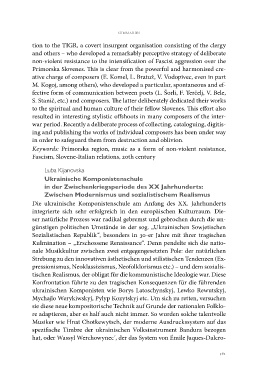Page 363 - Weiss, Jernej, ur. 2018. Nova glasba v “novi” Evropi med obema svetovnima vojnama ?? New Music in the “New” Europe Between the Two World Wars. Koper/Ljubljana: Založba Univerze na Primorskem in Festival Ljubljana. Studia musicologica Labacensia, 2
P. 363
summaries
tion to the TIGR, a covert insurgent organisation consisting of the clergy
and others – who developed a remarkably perceptive strategy of deliberate
non-violent resistance to the intensification of Fascist aggression over the
Primorska Slovenes. This is clear from the powerful and harmonised cre-
ative charge of composers (E. Komel, L. Bratuž, V. Vodopivec, even in part
M. Kogoj, among others), who developed a particular, spontaneous and ef-
fective form of communication between poets (L. Šorli, F. Terčelj, V. Bele,
S. Stanič, etc.) and composers. The latter deliberately dedicated their works
to the spiritual and human culture of their fellow Slovenes. This effort also
resulted in interesting stylistic offshoots in many composers of the inter-
war period. Recently a deliberate process of collecting, cataloguing, digitis-
ing and publishing the works of individual composers has been under way
in order to safeguard them from destruction and oblivion.
Keywords: Primorska region, music as a form of non-violent resistance,
Fascism, Slovene-Italian relations, 20th century
Luba Kijanovska
Ukrainische Komponistenschule
in der Zwischenkriegsperiode des XX Jahrhunderts:
Zwischen Modernismus und sozialistischem Realismus
Die ukrainische Komponistenschule am Anfang des XX. Jahrhunderts
integrierte sich sehr erfolgreich in den europäischen Kulturraum. Die-
ser natürliche Prozess war radikal gebremst und gebrochen durch die un-
günstigen politischen Umstände in der sog. „Ukrainischen Sowjetischen
Sozialistischen Republik“, besonders in 30-er Jahre mit ihrer tragischen
Kulmination – „Erschossene Renaissance“. Denn pendelte sich die natio-
nale Musikkultur zwischen zwei entgegengesetzten Pole: der natürlichen
Strebung zu den innovativen ästhetischen und stilistischen Tendenzen (Ex-
pressionismus, Neoklassizismus, Neofolklorismus etc.) – und dem sozialis-
tischen Realismus, der obligat für die kommunistische Ideologie war. Diese
Konfrontation führte zu den tragischen Konsequenzen für die führenden
ukrainischen Komponisten wie Borys Latoschynskyj, Lewko Rewutskyj,
Mychajlo Werykiwskyj, Pylyp Kozytskyj etc. Um sich zu retten, versuchen
sie diese neue kompositorische Technik auf Grunde der nationalen Folklo-
re adaptieren, aber es half auch nicht immer. So wurden solche talentvolle
Musiker wie Hnat Chotkewytsch, der moderne Ausdruckssystem auf das
spezifische Timbre der ukrainischen Volksinstrument Bandura bezogen
hat, oder Wassyl Werchowynec´, der das System von Émile Jaques-Dalcro-
361
tion to the TIGR, a covert insurgent organisation consisting of the clergy
and others – who developed a remarkably perceptive strategy of deliberate
non-violent resistance to the intensification of Fascist aggression over the
Primorska Slovenes. This is clear from the powerful and harmonised cre-
ative charge of composers (E. Komel, L. Bratuž, V. Vodopivec, even in part
M. Kogoj, among others), who developed a particular, spontaneous and ef-
fective form of communication between poets (L. Šorli, F. Terčelj, V. Bele,
S. Stanič, etc.) and composers. The latter deliberately dedicated their works
to the spiritual and human culture of their fellow Slovenes. This effort also
resulted in interesting stylistic offshoots in many composers of the inter-
war period. Recently a deliberate process of collecting, cataloguing, digitis-
ing and publishing the works of individual composers has been under way
in order to safeguard them from destruction and oblivion.
Keywords: Primorska region, music as a form of non-violent resistance,
Fascism, Slovene-Italian relations, 20th century
Luba Kijanovska
Ukrainische Komponistenschule
in der Zwischenkriegsperiode des XX Jahrhunderts:
Zwischen Modernismus und sozialistischem Realismus
Die ukrainische Komponistenschule am Anfang des XX. Jahrhunderts
integrierte sich sehr erfolgreich in den europäischen Kulturraum. Die-
ser natürliche Prozess war radikal gebremst und gebrochen durch die un-
günstigen politischen Umstände in der sog. „Ukrainischen Sowjetischen
Sozialistischen Republik“, besonders in 30-er Jahre mit ihrer tragischen
Kulmination – „Erschossene Renaissance“. Denn pendelte sich die natio-
nale Musikkultur zwischen zwei entgegengesetzten Pole: der natürlichen
Strebung zu den innovativen ästhetischen und stilistischen Tendenzen (Ex-
pressionismus, Neoklassizismus, Neofolklorismus etc.) – und dem sozialis-
tischen Realismus, der obligat für die kommunistische Ideologie war. Diese
Konfrontation führte zu den tragischen Konsequenzen für die führenden
ukrainischen Komponisten wie Borys Latoschynskyj, Lewko Rewutskyj,
Mychajlo Werykiwskyj, Pylyp Kozytskyj etc. Um sich zu retten, versuchen
sie diese neue kompositorische Technik auf Grunde der nationalen Folklo-
re adaptieren, aber es half auch nicht immer. So wurden solche talentvolle
Musiker wie Hnat Chotkewytsch, der moderne Ausdruckssystem auf das
spezifische Timbre der ukrainischen Volksinstrument Bandura bezogen
hat, oder Wassyl Werchowynec´, der das System von Émile Jaques-Dalcro-
361


